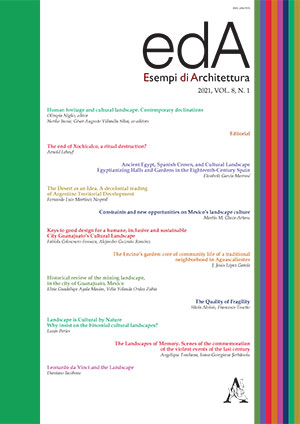Estratto da
ESEMPI DI ARCHITETTURA
International Journal of Architecture and Engineering
THE DESERT AS AN IDEA. A DECOLONIAL READING OF ARGENTINE TERRITORIAL DEVELOPMENT
ESEMPI DI ARCHITETTURA
International Journal of Architecture and Engineering
THE DESERT AS AN IDEA. A DECOLONIAL READING OF ARGENTINE TERRITORIAL DEVELOPMENT

“To say simply that Orientalism was a rationalization of colonial rule is to ignore the extent to which colonial rule was justified in advance by Orientalism, rather than after the fact.” (Said, 1994 [1978], p. 39)In 1982, Tulio Halperin Donghi, one of the most important Argentine historians of the 20th century, published a book entitled “One nation for the Argentine desert”, in which he explained how the 19th-century Argentinian elites’ believed that they were conceiving a new and prosper country from an inhabited and useless desert. However, this later was not a desert and was not inhabited and useless. It was the land where many groups of native populations lived. To this purpose, the white occupation of these territories, called “The desert campaigns”, was rather a war devoted to the systematic extermination of the natives hidden behind the idea of a “colonization” of this apparently empty desert.Many Argentinian intellectuals and politicians of those times, like Domingo Sarmiento (Argentinean Ambassador in the USA 1863–68 and Argentinean President 1868–74) contributed to this idea, including comparisons between the Sahara and the Pampa and between the Bedouins and the Gauchos, both as “barbarians”, both as opposed to civilization.After the desert campaigns and based on those ideas, the territorial development of the country was conceived as an extension of the borders of Western civilization beyond that imaginary desert. Railroads, cities, and extensive cattle ranches devoted to exportation occupied old native territories and generated an oligarchy of its owners who ruled the country for decades.This paper focuses on a case study, the city of Santa Rosa which epitomizes this process and its contradictions. The aim is to show the different facets of this orientalist image of Argentina and its relevance as a tool of an internal colonial project of the country.Keywords: Desert, Argentina, Territorial development.
| pagine: | 39-47 |
| DOI: | 10.4399/97888255398684 |
| data pubblicazione: | Dicembre 2020 |
| editore: | Aracne |








